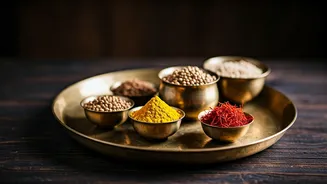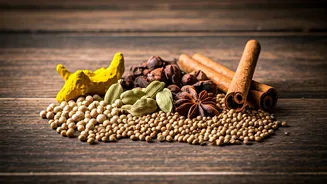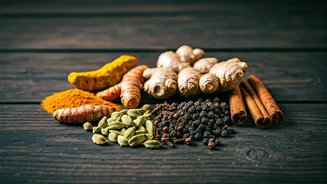Mindful Eating Practices
The first valuable ritual centers around mindful eating. This practice urges individuals to engage all their senses while consuming a meal. This is done
by focusing on the food's aroma, savoring its taste, and noting the texture and appearance. Mindful eating emphasizes eliminating distractions such as television or smartphones, which might lead to overeating. By concentrating on each bite, one can better understand their body's hunger and fullness cues. This helps in preventing overconsumption, promotes better digestion, and supports a more positive relationship with food. It emphasizes the importance of eating slowly, chewing food thoroughly, and appreciating the entire eating experience as a meditative act.
Seasonal Food Consumption
Another crucial aspect of Indian eating rituals is eating according to the seasons. This practice recommends consuming seasonal fruits and vegetables, as they are believed to provide the body with essential nutrients relevant to the specific weather conditions. For example, during summer, lighter foods like watermelons and cucumbers are favored for their cooling properties. In winter, richer, warming foods such as root vegetables and nuts are more prevalent. This ritual also aligns with the natural availability of produce, making meals fresher and more sustainable. This practice encourages a close connection with nature and the cyclical changes of the year, promoting overall well-being. By eating seasonally, individuals can support local farmers and reduce the environmental impact of their food choices.
Eating at Set Times
Traditional Indian households often adhere to a routine of eating meals at set times. Consistent meal timings are thought to aid digestion and help the body regulate its internal clock. Eating at predictable times can also assist in managing blood sugar levels and avoiding hunger pangs between meals. Breakfast is often considered the most important meal of the day, with lunch and dinner also given importance. Sticking to regular mealtimes helps establish a balanced dietary pattern and prevents overeating. It also provides a structure for daily activities. This ritual fosters discipline and promotes a healthier lifestyle. The concept is about ensuring the body gets the required nourishment on a regular basis.
Sharing Food Rituals
Sharing food is a deeply rooted tradition in Indian culture, representing unity, compassion, and the significance of community. Meals are commonly prepared and consumed together, signifying togetherness and gratitude. This ritual may involve sharing food with family, friends, and even guests, signifying hospitality and respect. It also extends beyond immediate social groups, with many Indian traditions promoting the sharing of food with the less fortunate. This act of sharing promotes a sense of belonging and strengthens social bonds. It embodies the values of generosity and empathy and emphasizes the concept of community over individualistic pursuits. This practice reflects the belief that food is a communal resource that should be enjoyed with others.
Spice Usage Wisdom
The use of spices is a fundamental aspect of Indian eating rituals. Spices are incorporated for flavoring and also because of their therapeutic properties. Many Indian spices, such as turmeric, ginger, and cumin, have anti-inflammatory, antioxidant, and digestive benefits. The art of combining spices in the right proportions enhances the flavors of meals and also supports overall health. This ritual is also about balancing the elements and promoting harmony within the body. In addition to their health benefits, spices are also used for their ability to aid digestion and stimulate metabolism. The use of spices is not merely about culinary enjoyment; it is a holistic approach to eating that supports physical well-being. This is a testament to the wisdom and experience of generations.













